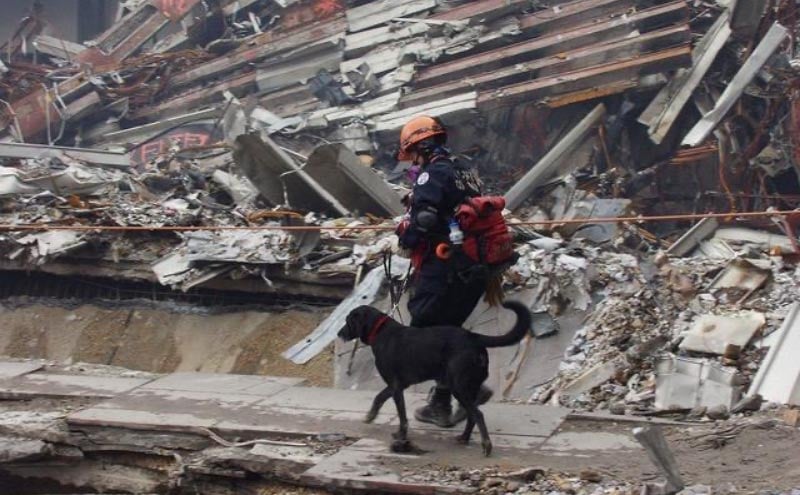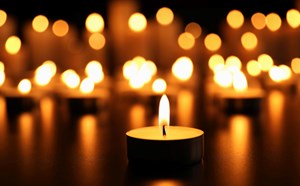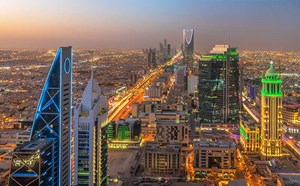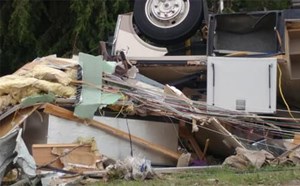
Reflections of 9/11
(Pictured above: Ann Wichmann and K9 Jenner at the WTC)
I would like to thank all who have contributed comments and invite anyone who wishes to share additional comments to send them to my email to be added.
With great respect,
Lillian Lockwood, MD, FACEP
kucoachbob@yahoo.com
The following are short excerpts of 9/11 reflections from Emergency Medicine physicians and first responder partners. Enjoy full comments on the following pages.
"I will never forget several moments …. we (Colorado Task Force 1) were stationed at Fort Dix, waiting for another attack at which we would be first on the scene, but thank heavens, that never occurred. I will never forget the frightened, eyes wide, face of a young black woman, wearing her fatigue helmet and carrying an assault weapon, scared to death but ready to go into anything …
As we approached the pile for the first time, I remember thinking that I would never send Jenner into that mass of burning, twisted metal …. and yet, when the Fire Chief asked if I would search, I said yes.
When we first entered the pile, he was so brave and so resolute that I had to be as calm as he was. The picture that I will include is this moment.
As we waited for our search assignment, a huge piece of twisted metal rotated above our heads …. apparently secure enough for us to be directly underneath it, but disconcerting at best. On a rainy, windy day, as we walked around the pile to get to a different search area, a huge plate glass window smashed directly in front of us, having fallen from one of the damaged buildings. I still find myself more easily startled than before the World Trade Center, and I think this one incident is the origin of that …. another odd manifestation of how PTSD affects us all differently.
And I will never forget finding a pink high-heeled shoe in a massive pile of broken glass ….
The moment that Jenner disappeared into the pile and was somewhere under the rubble for several long minutes ….
The young firefighter that was coming on to shift and dropped to his knees to talk to Jenner …. after several moments, he raised his blue eyes to me with tears streaming down his face and said “I lost 13 of my best friends here” …. then stood up and walked away.
And I thought then, and continue to think, of the desperate people who jumped that day …. no one expected to die that day, and the angst of their souls was everywhere."
-Ann Wichmann, K9 handler formerly of CO TF 1
"I was a third-year student on September 11, 2001. I was on rotation at St Michael's in Newark, NJ. Watched on TV and from the windows of the Resident's call room area as the towers fell. While the medical education department attempted to dismiss the students, many of us volunteered to stay and help. We were teamed up with interns and residents to identify as many patients as possible that could be safely discharged to open beds for the anticipated flood of casualties -- that never came. Every hospital within 100 miles of NYC was placed on alert to expect injured given the massive number of people who worked in the two towers on a daily basis -- 50,000 workers and over 200,000 visitors.
Prior to medical school, I had been a firefighter / EMT for 9 years. My hometown department (Middletown Township, NJ) responded to Atlantic Highlands, NJ where the commercial ferries were working overtime to evacuate as many people as possible, they had to be decontaminated and many were transported to local shore hospitals for evaluation. A similar process was taking place at the northern NJ ferry terminals.
Phone lines were jammed. Could get through to anyone, especially my father who worked on Broadway or my mother who was down the Jersey Shore. It would take my father all day to make his way home, a commute that usually only took 1 hour. The strangest thing was the sound of silence in the air... no jets were flying. In the NYC region that is strange as there are three major international airports, so air traffic was always background noise.
I and a number of other osteopathic students spent weekends over the next few months offering manipulation therapy at Nino's Restaurant on Canal Street under the supervision of some of our DO mentors. The sheer look of exhaustion on the faces of firefighters and construction workers is still etched into my mind.
Sorry for the ramble. Sadly, after watching my former place of employment attempt to deal with the COVID pandemic, I wonder if the lessons of 9-11 were truly learned or just acknowledged and pushed to a bookshelf to be forgotten. Perhaps, the devastation of COVID could have been minimized had more administrators remembered the lessons of that sad day."
-Sean Finnerty DO
"Yes, I remember 9/11/2001 well.
I live on the west coast, so my clock/radio had gone off just before 6 am and the attack on the World Trade Center was just starting to be reported—so immediately turned on the TV and saw the second plane hit the World Trade Center and later events unfold at Pentagon and with United flight 93.
As the Team Commander/Supervisory Medical Officer of the Disaster Medical Assistance (DMAT) Team representing Oregon in the National Disaster Medical System, I began alert callouts to be ready to deploy a potential standard 35-person response team, although it was not our usual month to support a rotation.
I had a colleague who worked at the WTC complex, so was trying also to try to learn if he was ok.
Two Oregon DMAT physicians from Oregon Health and Science University happened to already be in NY City for a medical meeting and were promptly reaching out to support FDNY at local aid stations (Drs. Terri Schmidt and Mohammed Daya).
All aircraft and flights were grounded so we knew teams from NJ, MA, RI etc. would likely go by ground. And knew that our regional Disaster Mortuary Operational
response teams would also be activating….and likely have a long and complex mission ahead.
As the Pentagon was hit and United 93 had crashed, it was unclear what other targets there might be—or what exactly was happening.
Our Oregon DMAT team was immediately placed on official Advisory status and then quickly upgraded to Alert status by US Department of Health and Human Services Office of Emergency Response. I called down and staffed the 44-position team that was requested, and we then remained on alert status for a three-month period, with a team always Immediately available.
I also was leading a nonprofit volunteer medical outreach team of 28 people to a remote rural village in Haiti in a few weeks, so many questions were arising about the status of that project as well.
It was to say the least a very long day that blended into the next. Later I noted over 360 emails from that date.
Senator Gordon Smith addressed the US Senate on the day following the attacks. He concluded his remarks,” I take this opportunity to recognize some Oregonians who are doing their part to respond to this tragedy. The Oregon Disaster Medical Assistance Team has assembled and is prepared for immediate deployment by the Office of Emergency Preparedness. Many of their colleagues have already been deployed; the Oregon team is still on the ground awaiting availability or air transport. Their courage and willingness to serve is one of many bright lights that have brightened this dark day.”
In addition to emergency physician team members Terri Schmidt and Mo Daya who were already in NY, nineteen additional Oregon DMAT Team members were deployed in that mid-September to mid-November timeframe including emergency medicine physicians: Jonathan Jui, Rodney Dodge, J. Brent Sholar, Eustacia “Jo” Su, Beverly Bauman, and Helen Miller.
Our primary mission was to provide onsite medical and mental health care for rescue and recovery workers at the ground zero/World Trade Center site. We had bases of Operation at Liberty Street and Church Street within the site perimeter.
Individual team members also provided intensive burn care nursing to victims, and I had the opportunity to later work with CDC to treat NY postal workers exposed to anthrax. Our administrative officer also served at the Emergency Operations Center at the Federal Office of Emergency Preparedness near Washington DC.
I also remember juggling to get my kids to school that day…. trying to reassure them and not have them watch it over and over on tv.
Thankfully they did not replay the video of people jumping from the towers…I recall just finding that I unconsciously had put my hand over my mouth when watching it in real time.
Have seen patients and families have that reflex when hearing bad news or seeing something tragic. Had not been aware of myself having that reaction previously…
United We Stand
The unity we felt as a country and when serving there will also never be forgotten.
One of my rural EMTs—who passed away too young, unclear if related to exposures there…had the opportunity to briefly meet the President as he toured the site.
Our team had a chance to share the moment the fire command post was found in the rubble and to be invited that night to stand witness to the bodies of their fallen brothers to be carried out draped in flags… on the night shift to avoid media cameras. Many moments also with patients …that of course will remain confidential always.
And of course, getting work coverage to be away etc."
-Helen Miller, MD, FAAP, FACEP
“I was a second-year med student on 9/11/2001. I am now a DMAT Medical Officer for NY-6. Here is what I shared with residents 3 years ago.
Last week we remembered September 11th.
Personally, I will never forget September 11th, 2001.
I will never forget my drive to help until total mind and body exhaustion felled me days later.
Nevertheless, I can easily remember what I did that day.
I remember waking up to go to the anatomy lab to study for the test on the upper and lower extremities that was going to be held September 12. The instructor let me know that a plane had crashed into one of the twin towers.
I remember going up to the top of the dorms and seeing two plumes of smoke and knew immediately this was no ‘accident.’
Thankfully the test was postponed as the rest of our lives were similarly postponed.
I remember helping create student volunteer lists and available times to provide to administration where we provided direction and guidance for families who were fruitlessly searching throughout lower Manhattan for their loved ones at hospitals. We met the distraught family members at the entrance of NYU’s Tisch Hospital.
I remember seeing physicians, residents, and students turned away from the Bellevue ED since they were staffed out their ears with medical professionals.
I remember piling into a police car that afternoon after stuffing the back seat and trunk to the brim with supplies for a hastily setup triage site at a Chelsea Piers’ warehouse.
I remember driving across Manhattan with myself, an ED intern, and the NYPD officer from 1st to 11th avenue with no other cars on 34th street. Surreal incarnate.
I remember helping set up ten times as many fold-out tables as were needed where the expected patients that barely materialized could lay if needed. The tables were not needed for patients but for food brought by surrounding restaurants.
I remember being paired with a resident and a general surgeon who was visiting from Florida for a general surgery conference in Midtown that week and we listened as he talked about mass casualty preparation. None of our preparation was the right preparation and we spun our wheels. Now that I am a veteran DMAT medical officer, I realize that the medical response still spins its wheels, but less often and at lower speeds.
I remember the lines of fellow New Yorkers lining up to give blood and the compassion for police, EMS, and especially firefighters. It pains me to see our Congress drag its feet supporting the affected first responders.
I remember my fiancée, in London at the time, struggling to comprehend how our lives were upended with all air travel halted for a week. I remember meeting my friend that week who had been in the A-train under Ground Zero when the first plane hit, and he had to be evacuated by foot from the subway.
I remember the coroner’s office below our dorms and down the hall were overwhelmed with body bags. The white fluid-resistant body bags filled with human and animal detritus from Fresh Kills. Yes, Fresh Kills landfill. The refrigerated 40-foot trailers were lined up in rows in the parking lot across the street from my dorm room like orderly larger-than-life coffins in a cemetery. I slept on the 2nd floor overseeing the trailers for the rest of that year.
I remember my fellow students who each were affected in their own way. Most were somber, some threw themselves into studies to cope. Others volunteered in the coroner’s to help sort human bones from non-human bones. I remember volunteering once. After seeing a foot in a boot, I excused myself and realized that I would never be a forensic pathologist.
I will never forget September 11th.”
-Antony Hsu MD, FACEP
“I humbly believe it would be worth mentioning Dr. Bosche who died from synovial sarcoma of the lung, a rare cancer that has been associated with 9/11 first responders. While I did not know him personally, I know many that did, and it seems that he was a good man who ultimately died as a result of his service and response to 9/11.”
Remembering Christopher J. Bosche
-Brian Openlander, MD
“I spend 2-weeks at Ground 0 with the Oklahoma DMAT. I think my biggest takeaway is that 9/11 changed the way we think about disasters in the US, and like COVID it was a game changer.
The only time I’ve ever cried was when we went to the informal memorial set up at ground zero. All the candles, flowers, and notes to friends and family members. It made it so personal and got me thinking about how so many lives had been changed in an instant - not just those who had died, but the ripple effect on those who had the burden to continue living despite their loss.”
-Douglas M. Char, MD Professor of Emergency Medicine
Associate Vice-Chair of Faculty Development
Medical Director, SOM Clinician Peer Support Program
Department of Emergency Medicine
Washington University School of Medicine
“I was the Medical Team Manager of Ohio Task Force One based in Dayton, Ohio, a member of the FEMA Urban Search and Rescue Response System. We were deployed before noon on 9–11-2001 and began making our way by ground to New York City that afternoon. Initial reports we received while traveling across Pennsylvania were quite ominous as we struggled to get fuel through the long lines. There definitely was much trepidation among us about what we might find at our destination.
We arrived in New Jersey and got our first view of the smoke rising from lower Manhattan just after sunrise on 9-12. We set up our base of operations at the Javits Center and then proceeded to Ground Zero. As we slowly progressed southward, we encountered more debris, dust, as well as damaged and unattended pieces of fire apparatus which gave silent testimony to the number of missing firefighters. At one stage, we had to exit and free hose couplings that had become entangled in our rear wheels. To that point, the largest collapse incident was the Murrah building bombing in Oklahoma City. So, the environment we encountered in lower Manhattan was unlike any experienced prior by the system. Our respiratory protection was inadequate initially. We were assigned to the Liberty Street section and set up a forward base of operation at a Chase bank branch on South End Ave just opposite the then World Financial Center. For nearly 10 days, we conducted various missions 24/7 in the debris field as well as the evacuated adjacent buildings. We were on site when the last survivor was extracted. The hope that more would be found was all but extinguished over the next 48 to 72 hours. However, we continued to work in coordination with the FDNY locating remains and clearing the surrounding structures leaving no space that could contain victims uninspected.
The task force experienced no major injuries, one medical event requiring transport, and canine issues including paw lacerations and dehydration. However, the real medical issues for OH TF-1 came in the weeks, months, and years after.
9-11 was our first federal deployment, and since that time Ohio Task Force One has responded to numerous incidents with hurricanes being the most frequent type. We are proud of our service, and I continue to be an active member of Ohio Task Force One having most recently deployed to the Champlain Towers collapse in Surfside, Florida.
At this time of year, I think mostly of those are lost their lives as well as those who lost loved ones. Also, I think of those are responded without question or hesitation. It was one of our country's worst days and at the same time maybe one of our proudest. It was my privilege to serve and care for the member of Ohio Task Force One. Thank you for allowing me to share my story.”
-Randy Marriott, MD, FACEP, FAEMS
Medical Director
Ohio Task Force One
Dayton, Ohio
“I was the Command Physician at the Pentagon on 9/11.”
-Thorn Mayer MD, FACEP
“I was working for CMS that day, heard about the 1st plane as I got out of my car and looked up at the clear sky. In the director’s suite, we watched the 2nd plane hit. My #3 was in NYC in our offices in one of the smaller buildings in the complex. He was a former military policeman and efficiently got our people out and away. I then cleared my division personnel out of the CMS building – we didn’t know what would be hit next. One of my team was in the hallway weeping. She said, “Dr. Hill, I don’t know how our intelligence services failed us.” After my site was secure, I drove to my PT ED in Baltimore where I found a heart-stopping number of medical staff of all specialties gathered, all coming with the question, “How can we help?” We learned that we were “3rd do” expecting to get patients when NJ and PA were full. Of course, none came. They all died.”
-Hugh Hill MD, JD, FACEP
“I was part of MA2 Disaster Medical Team. I sent daily dispatches to home to my dad which he saved but were unfortunately lost when he recently passed away. I no longer have that computer so they are not retrievable.”
-Cynthia Aaron, MD, FACEP
References
- Azofeifa A, Martin GR, Santiago-Colón A, Reissman DB, Howard J. World Trade Center Health Program — United States, 2012−2020. MMWR Surveill Summ 2021;70(No. SS-4):1–21. - Learn More
- U.S. Department of Homeland Security | USA Gov - Learn More



